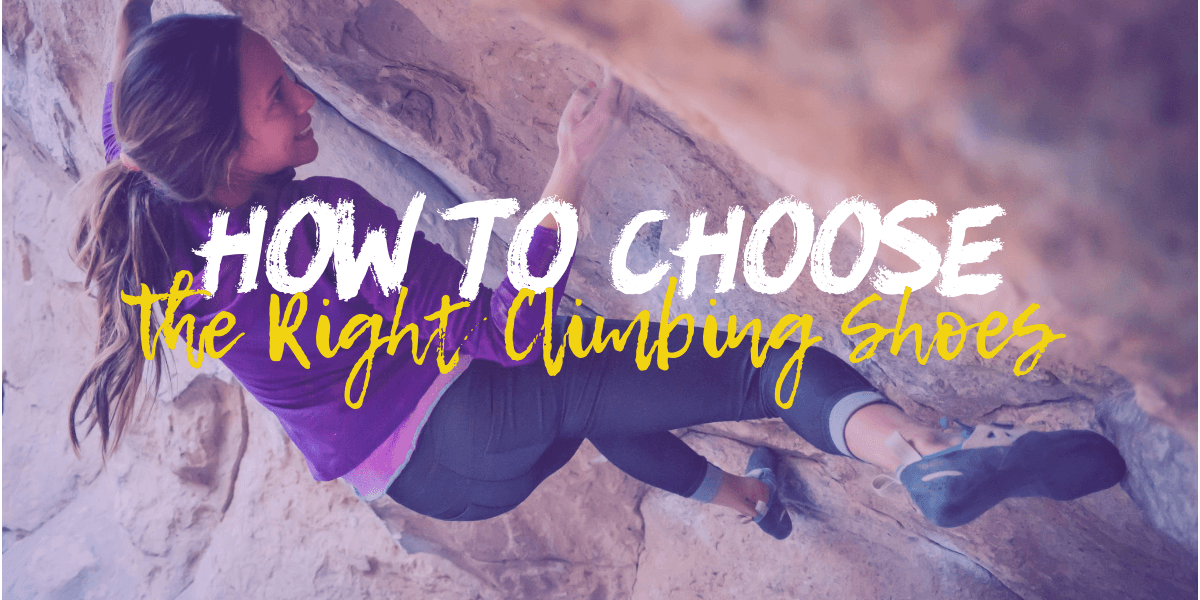How to Choose the Right Rock Climbing Shoes

If you’re in the market for a pair of rock climbing shoes, look no further than this post.
We’ll guide you through everything you need to keep in mind when choosing the best footwear for your climbing adventures!
1. Identify Your Climbing Needs
Before you start browsing rock climbing shoes, keep in mind that the shoe for you will depend upon your climbing needs. More advanced wilderness climbers will require very different footwear than beginner boulderers.
Take a minute to identify what you anticipate using your rock climbing shoes for. Are you just starting out in the sport of rock climbing? Will you be spending your weekends at the local rock climbing gym? Or are you gearing up to lead rock climbing on El Capitan?
What’s more, when you get to that rock, what type of climbing will you be doing? There’s a difference between bouldering and climbing gym walls versus navigating off-width cracks and crags.
Your climbing needs can help you determine your climbing shoe profile, flexibility, and material.
2. Know What Shoe Size is Comfortable to You
A lot of beginner climbers don’t realize that their street shoeswon’t match the sizing of their ideal pair of rock climbing shoes. The two are crafted based off of entirely different sizing scales, and this applies to both men’s and women’s shoes.
What’s more, a climbing shoe that fits you well won’t be loose and necessarily comfy. The ideal shoe should be snug without leading to compromising blisters and hot spots.
A snug shoe will enable you to ascend any rock wall with gecko-like deftness. It’s important to minimize any distance between your toes and the rock wall itself.
Because sizing is so unfamiliar to most people starting out in rock climbing, it’s essential to try on some actual shoes. Even if you end up purchasing some shoes online—and we recommend this, especially if you’re buying from a trusted retailer like Butora—stop by a climbing shop in your area to get a sense of fit.
3. Decide on Profile Shape
Once you’ve determined your climbing shoe size, it’s time to decide on a shoe profile shape. No climbing shoe is the same, but the best way to differentiate the typical climbing shoes is by their profile. Different profiles can assist in various terrains.
In general, climbing shoes will have a hooked-toe, flat-lasted, or cambered-last shape. Don’t be intimidated by this terminology.
Hooked toe shoes are ideal for more expert climbers needing a powerful shoe to ascend difficult, unpredictable crag. The hooked toe enables climbers to access difficult footholds and ascend overhanging faces.
Cambered-last shoes are in a similar category, ideal for intermediate to advanced climbers. They are less “hooked” than hooked toe shoes, but they still enable climbers to access small footholds and ascend vertical crag.
Flat-lasted shoes are less snug than the hooked toe or cambered last shoes. Most beginners will choose flat lasted shoes because they are comfortable for bouldering and ascending standard rock walls.
Select your profile type based off of the kind of climbing you anticipate doing in the coming months.
4. Select the Material
Rock climbing shoes will be crafted from a pliable but durable material. Many shoes are made out of leather or a similar counterpart. Others are made out of synthetic fabrics and materials.The material you choose will be based on your comfort preferences.
Leather shoes tend to be more breathable than synthetic ones, so if your feet sweat a lot during climbing sessions, these may be ideal for you. Synthetic shoes are less likely to stretch out over time, however, because they are crafted from less flexible material.
Most shoes will have rubber soles to enable better gripping. Inspect the soles of rock climbing shoes to ensure that the traction suits your climbing needs.
Lastly, pay attention to each shoe’s fastening system. Many rock climbing shoes will have standard lace-ups, much like a traditional tennis shoe. Others will have velcro closures.
A shoe’s lacing can impact your climbing experience. Laces can come undone, for example, while velcro fasteners may not give you the snugness you require.It’s important to try on shoes of different materials and fastening systems to identify what’s best for you.
5. Research Leading Brands
Rock climbing shoes take quite a beating, no matter what your skill level is as a rock climber. As such, it’s essential to purchase a high-quality shoe from a trusted manufacturer.
The best manufacturers may even offer ongoing customer support and limited warranties. What’s more, trusted brands will be well-versed in the climbing industry itself, much like Butora.
Spend some time researching leading manufacturers of the industry. Consult friends and family members about brands they recommend when it comes to climbing shoes.
Make sure the shoe manufacturer you do choose can offer expert knowledge and assistance about shoe selection.
6. Test Performance
Once you bring those new shoes to the wall, test their performance rigorously. Don’t be shy about returning any shoe that doesn’t suit your needs.
Check with your manufacturer regarding return policies. If possible, try out your new shoes on a cleaner wall, such as one in a rock climbing gym, to minimize damage.
How to Find The Best Pair of Rock Climbing Shoes
Rock climbing is a growing sport that daily welcomes new athletes. If you’re breaking into the sport for the first time, it’s vital to find a comfortable pair of climbing shoes.
Know your shoe size and climbing needs before you start purchasing. Try on shoes from local retailers to get a sense of the profile and fit that work for you.
Lastly, always purchase from a trusted manufacturer and test out any pairs you purchase on the wall itself.




